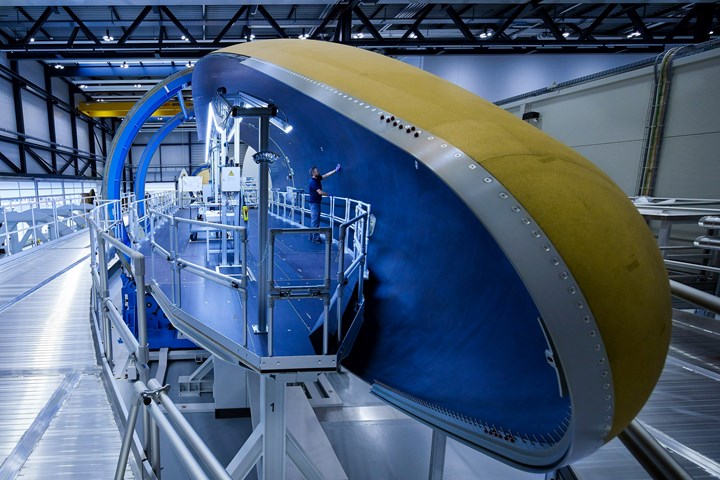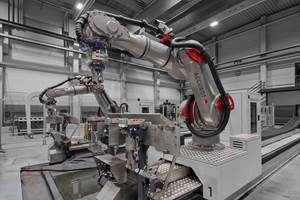RUAG International reports 7% sales growth, positive profit development
Expanding production and large orders in RUAG International’s Space division, rebranded Beyond Gravity, leads sales growth.

In its half-year results released Sept. 6, 2022, RUAG International (Zurich, Switzerland) reported sales up 1% compared to the same period last year, to CHF 581 million, amounting to 7% adjusted for foreign currency and divestment effects.
Sales in the Space, Aerostructures and Small Caliber Ammunition segments generally developed positively compared to the prior-year period. The MRO International segment recorded a significant decline in sales due to the divestment of the Simulation & Training (S&T) business at the end of April.
EBIT increased from CHF 27 million to CHF 100 million compared to the previous year, with a significant portion resulting from the sale of the S&T business. Both the Space segment and the Aerostructures business generated an operating profit in the first half of the year and improved significantly compared to the same period last year.
In the first half of 2022, RUAG says further non-strategically relevant business units were sold and the company drove forward a transformation towards an agile company focused on the space market. The Space segment, with around 1,700 employees, was renamed Beyond Gravity (previously RUAG Space) in mid-March 2022.
According to RUAG, orders from large, commercial space providers such as Amazon are leading Beyond Gravity to the expansion of production sites in Linköping, Sweden and in Decatur, Ala., U.S. Construction is progressing on an additional production facility in Linköping and is said to create jobs for around 60 new employees. An expansion of production is also planned at the Decatur site, which will result in an increase in the workforce of 200 additional jobs.
In mid-March, RUAG International signed a sales agreement with the Italian hunting and sporting weapons manufacturer Beretta for its ammunition business (RUAG Ammotec). Beretta Holding took over all 2,700 employees at all production and sales sites as early as the end of July 2022.
At the end of April, ownership of all shares in RUAG Simulation & Training was transferred to the French company Thales. At the beginning of May, Thales took over all business activities and all 500 employees in four countries.
The sale of RUAG Australia to the Australian defense and manufacturing company ASDAM was also closed at the end of August. ASDAM took over all activities of RUAG Australia, including all 150 employees at all sites in Australia.
By the end of 2023, RUAG International also intends to find suitable partners for the two aerostructures units in Switzerland and Germany/Hungary. For the rebranded Space division Beyond Gravity, a divestment is planned by the end of 2025 at the latest. With the completion of these divestments, the Swiss Confederation will then no longer have any shares in RUAG International Holding.
In addition, as of May 1 2022, André Wall took over as Head of the Space division in addition to his role as CEO of RUAG International.
Demand for the Space and Aerospace business is still expected to remain stable. However, due to the loss of sales from the divested Ammotec, Simulation & Training and RUAG Australia businesses, RUAG International expects significantly lower sales overall for 2022 as a whole.
Related Content
Revolutionizing space composites: A new era of satellite materials
A new approach for high volumes of small satellite structures uses low-CTE, low-cost CFRP cellular core, robust single-ply skins and modular panel systems to cut lead time, labor and cost for reflectors, solar arrays and more.
Read MoreAutomated robotic NDT enhances capabilities for composites
Kineco Kaman Composites India uses a bespoke Fill Accubot ultrasonic testing system to boost inspection efficiency and productivity.
Read MoreNASA launches composite solar sail into space
Sunlight-based propulsion system, supported by carbon fiber-reinforced booms, will undergo weeks-long testing to demonstrate and verify its capabilities.
Read MoreOptimizing a CFRP landing leg demonstrator
MT Aerospace achieves design for manufacturing, integrating multiple elements into one-piece structure using AFP and 3D printed tooling to meet time and budget constraints.
Read MoreRead Next
Scaling up, optimizing the flax fiber composite camper
Greenlander’s Sherpa RV cab, which is largely constructed from flax fiber/bio-epoxy sandwich panels, nears commercial production readiness and next-generation scale-up.
Read MoreNext-gen fan blades: Hybrid twin RTM, printed sensors, laser shock disassembly
MORPHO project demonstrates blade with 20% faster RTM cure cycle, uses AI-based monitoring for improved maintenance/life cycle management and proves laser shock disassembly for recycling.
Read MoreCeramic matrix composites: Faster, cheaper, higher temperature
New players proliferate, increasing CMC materials and manufacturing capacity, novel processes and automation to meet demand for higher part volumes and performance.
Read More.jpg;width=70;height=70;mode=crop)












